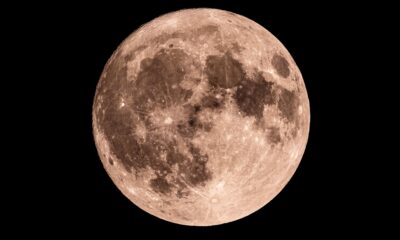Science
NASA Unveils Stunning Images of Interstellar Comet 3I/ATLAS

NASA has released new images of the interstellar comet 3I/ATLAS, a rare cosmic visitor that has sparked excitement among scientists since its discovery earlier this year. This remarkable comet, which is only the third known interstellar object to enter our solar system, has been the subject of intense observation from multiple NASA spacecraft.
On November 19, 2025, NASA showcased images captured by various instruments, including the James Webb Space Telescope, the Mars Reconnaissance Orbiter, and the Perseverance Mars rover. A total of 15 different missions are actively monitoring the comet, reflecting the scientific community’s eagerness to gather data on this unique object.
Insights from the Latest Observations
During a press briefing, Nicky Fox, associate administrator of NASA’s Science Mission Directorate, emphasized the agency’s commitment to pushing the limits of its instruments. “We’ve even pushed our scientific instruments beyond their normal capabilities to allow us to capture this amazing glimpse at this interstellar traveler,” she stated.
The images reveal comet 3I/ATLAS as a faint smudge against a star-filled background. Captured by the Perseverance Mars rover on October 4, 2025, the comet was approximately 18.6 million miles (29.9 million kilometers) from the rover at the time. NASA officials confirmed that all evidence points to it being a comet, dispelling any theories suggesting it might be an alien spacecraft. “It looks and behaves like a comet, and all evidence points to it being a comet,” said Amit Kshatriya, NASA Associate Administrator.
Adding to the intrigue, the James Webb Space Telescope and the SPHEREx space telescope provided valuable infrared data, revealing the presence of carbon dioxide and water ice in the comet’s nucleus. “We detected an abundance of carbon dioxide gas in the comet’s coma,” noted Shawn Domagal-Goldman, acting director of NASA’s Astrophysics Division, highlighting the importance of the findings.
A Unique Opportunity for Scientific Discovery
The arrival of comet 3I/ATLAS presents a rare chance for scientists to compare ancient dust from an interstellar source with material from our solar system. “It’s a rare opportunity to compare ancient dust from a distant solar system to that from our own,” Domagal-Goldman stated during the briefing.
NASA’s Mars Reconnaissance Orbiter was the closest spacecraft to the comet when it captured images on October 2, 2025. The orbiter’s HiRISE camera depicted the comet as a fuzzy white ball, indicative of the dust and ice cloud known as the coma. “That ball is a cloud of dust and ice shed by the comet as it continues its trajectory towards the sun,” Kshatriya explained.
The observation efforts have been coordinated among various spacecraft to maximize data collection as comet 3I/ATLAS moves through our solar system. NASA’s Psyche mission and the Lucy spacecraft also contributed to the data pool, with Psyche capturing images while about 33 million miles (53 million kilometers) from the comet.
As the comet approaches the sun, it has exhibited unusual characteristics, including a rapid brightening and the presence of nickel vapor surrounding it. “That’s really interesting, really remarkable, and something to be studied in the future,” commented Tom Statler, NASA’s lead scientist for solar system small bodies.
The extensive observations will not only deepen our understanding of comet 3I/ATLAS but also enhance our knowledge of the conditions around other stars. “Understanding the dynamics and composition of such distant cosmic objects can help us decode what the environments are like around other stars,” Fox added.
As comet 3I/ATLAS continues its journey, the James Webb Space Telescope is expected to be among the last spacecraft to observe it, capturing its final moments in our vicinity. The ongoing study of this interstellar comet may reveal insights into its origins and the environments from which it came, offering a glimpse into the cosmic past that predates our solar system.
-

 Technology4 months ago
Technology4 months agoDiscover the Top 10 Calorie Counting Apps of 2025
-

 Health2 months ago
Health2 months agoBella Hadid Shares Health Update After Treatment for Lyme Disease
-

 Health3 months ago
Health3 months agoErin Bates Shares Recovery Update Following Sepsis Complications
-

 Technology3 weeks ago
Technology3 weeks agoDiscover 2025’s Top GPUs for Exceptional 4K Gaming Performance
-

 Technology4 months ago
Technology4 months agoDiscover How to Reverse Image Search Using ChatGPT Effortlessly
-

 Technology2 months ago
Technology2 months agoElectric Moto Influencer Surronster Arrested in Tijuana
-

 Technology4 months ago
Technology4 months agoMeta Initiates $60B AI Data Center Expansion, Starting in Ohio
-

 Technology4 months ago
Technology4 months agoRecovering a Suspended TikTok Account: A Step-by-Step Guide
-

 Health4 months ago
Health4 months agoTested: Rab Firewall Mountain Jacket Survives Harsh Conditions
-

 Lifestyle4 months ago
Lifestyle4 months agoBelton Family Reunites After Daughter Survives Hill Country Floods
-

 Technology3 months ago
Technology3 months agoUncovering the Top Five Most Challenging Motorcycles to Ride
-

 Technology4 weeks ago
Technology4 weeks agoDiscover the Best Wireless Earbuds for Every Lifestyle



















